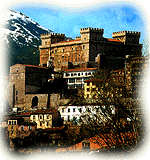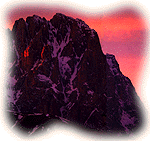 |

|
|
GENERAL INFORMATION |
|
| The mountains, which have modelled the character of the people, have favoured the continuation of ancient traditions. Many objects, customs and traditions that have survived till the present day are rooted in prehistory, of which the region has the most complete collection of remains in Italy. The incredible geographical variety of this area covering ten thousand square kilometres, with plateaus, hills and high mountains rolling down to the sea, has always allowed human life, both in glacial periods and in hot periods, when elephants, hippopotamuses and rhinoceroses roamed the shores of its lakes. The use of clothing made of goat or sheep skin, shoes made of strips of hide, vessels made of horn or pumpkins and many other primitive objects ceased only when industrialization became prevalent. Pagan ritual has stubbornly resisted Christianity. Medieval abbeys took the place of pagan temples only in the eighth or ninth century, in the same places of worship. Even the names of some of them contain precise pagan references: San Giovanni in Venere, Santa Maria Ara-Bona. Caves or sheltering places among the rocks where ritual had been carried out in prehistoric times attracted mystic hermits in the Middle Ages and religious pilgrims up until just a few decades ago. Many religious ceremonies, especially on the occasion of local festivities, still clearly show their pagan origin. The rough dialect maintains unchanged several words or expression of greeting in the purest Latin, which have completely disappeared from the Italian language. The most representative moments for the Benedictine Order's influence on style in Abruzzo, which have been of considerable historic and artistic significance, are: the Abbey of San Liberatore a Maiella, at Serramonacesca (late 10th century); S. Clemente a Casauria, at Castiglione a Casauria (11th century); Santa Maria di Catignano, at Bussi, and San Pietro ad Oratorium, at Capestrano (13th century), San Giovanni ad Insulam, at Isola del Gran Sasso (late 12th century) and Santa Maria di Propezzano in the Val Vomano. Alongside this rural world rich in archaic traditions there are, however, at the foot of the mountains, a number of centres specialized in artistic craft products that can easily stand comparison with regions that are richer and more fortunate from a geographical point of view. High quality jewellery was already being produced in the Middle Ages and achieved a fine artistic expression during the Reinaissance, especially at Sulmone, Guardiagrele and Pescocostanzo. This, then, is a land rich in its old past, where the rare presence of man has left even more room for unspoilt nature (about twenty Nature Reserves have been estabilished, six of which are cared for by the WWF: Lake Penne, Lake Serranella, East Maiella, Forca di Penne, Abetina di Rosello and Gole del Sagittario) and for three National Parks. The oldest of these, the Abruzzo Park, now has two new "brothers": the Gran Sasso-Laga Park and the Maiella-Morrone Park, the official borders of which are shortly to be defined. Almost the only traces of man's presence are those left by the huntsmen of the Palaeolithic period. A land inhabited by people who had a special veneration for Mars (whom the Sabines called "Mamers") and were brave, but also kind and hospitable. These features are still being handed down in Abruzzo families today.
|
||



